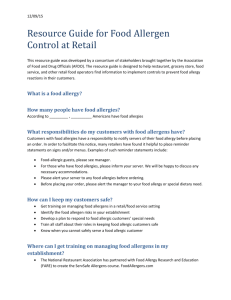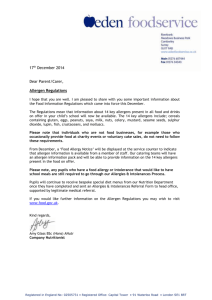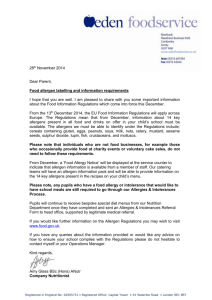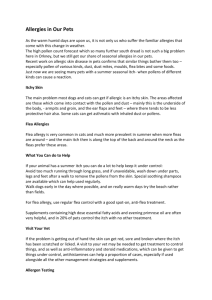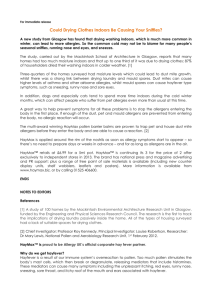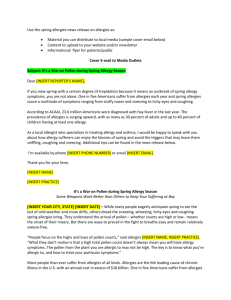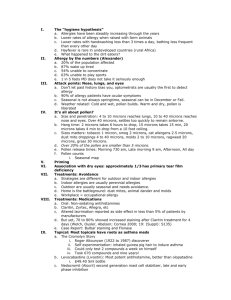March 2014 Wellness Newsletter - Crawford County R
advertisement
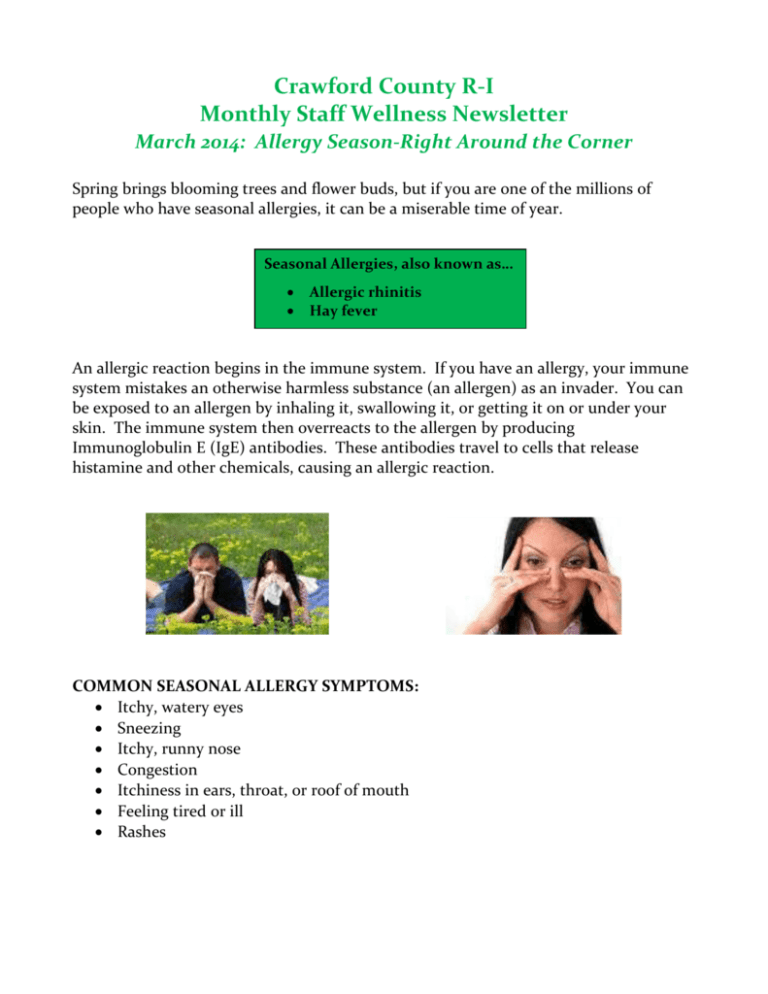
Crawford County R-I Monthly Staff Wellness Newsletter March 2014: Allergy Season-Right Around the Corner Spring brings blooming trees and flower buds, but if you are one of the millions of people who have seasonal allergies, it can be a miserable time of year. Seasonal Allergies, also known as… Allergic rhinitis Hay fever An allergic reaction begins in the immune system. If you have an allergy, your immune system mistakes an otherwise harmless substance (an allergen) as an invader. You can be exposed to an allergen by inhaling it, swallowing it, or getting it on or under your skin. The immune system then overreacts to the allergen by producing Immunoglobulin E (IgE) antibodies. These antibodies travel to cells that release histamine and other chemicals, causing an allergic reaction. COMMON SEASONAL ALLERGY SYMPTOMS: Itchy, watery eyes Sneezing Itchy, runny nose Congestion Itchiness in ears, throat, or roof of mouth Feeling tired or ill Rashes IS IT A COLD OR AN ALLERGY? Symptoms Cough General aches, pains Fatigue, weakness Itchy eyes Sneezing Sore throat Runny nose Stuffy nose Fever Duration Cold Common Slight Sometimes Rare or Never Usual Common Common Common Rare 3-14 Days Airborne Allergy Sometimes Never Sometimes Common Usual Sometimes Common Common Never Weeks (6 weeks for ragweed or grass pollen seasons) DIAGNOSIS: Knowing exactly what you’re allergic to can help you lessen or prevent exposure and treat your reactions. Visit an allergist/immunologist. An allergist has specialized training to help with more accurate diagnosing, finding a treatment plan that works for you, and providing educational information to help you manage your allergies. Allergy skin tests-considered the most sensitive testing method and provides rapid results. The most common test, the “prick test,” involves pricking the skin with an extract of a specific allergen, then observing the skin for a reaction. Serum-specific IgE antibody testing-blood test which provides information similar to that of an allergy skin test TREATMENT: Avoidance of the Allergen=best treatment (hard to do with airborne allergies) Antihistamines-counter the effects of histamine; Note: The newest drugs do not cause sleepiness side effect common with older generation of antihistamines. Nasal steroids=anti-inflammatory sprays that helps decrease inflammation, swelling, and mucous production Cromolyn sodium=a nasal spray that can help stop hay fever by blocking release of histamine and other symptom-producing chemicals Decongestants-thin nasal secretions and can reduce swelling and sinus discomfort (intended for short-term use) Immunotherapy/Allergy shots-may provide relief for patients who had none with antihistamines or nasal steroids; alter the body’s immune response to allergens to help prevent allergic reactions; treatment limited due to side effects STRATEGIES TO HELP CONTROL SEASONAL ALLERGIES: Reduce Exposure to Allergens: Stay indoors on dry, windy days. Delegate lawn mowing, weed pulling, leaf raking, and other gardening chores that stir-up allergens. Remove clothes you’ve worn outside and shower to rinse pollen from your skin and hair. Don’t hang laundry outside-pollen can stick to sheets and towels. Wear a dust/pollen mask if you must do outside work. Take Extra Steps When Pollen and Mold Counts Are High: Check your local TV or radio station or the Internet for pollen and mold forecast and current levels. If high counts are forecasted, start taking allergy medication before your symptoms start. Close doors and windows at night or any other time when counts are high. Avoid outdoor activity, especially early in the morning, when pollen counts are highest. Keep Indoor Air Clean: Keep windows closed and use the air conditioning (which cleans, cools, & dries the air) in your home & car. Use high-efficiency filters and follow regular maintenance schedules if you have forced air heating or air conditioning in your house. Keep indoor air dry with a dehumidifier. Use a portable high-efficiency particulate air (HEPA) filter in your bedroom. Clean floors often with a vacuum cleaner that has a HEPA filter. Note: Seasonal allergy symptoms are often less prominent on rainy, cloudy, or windless days because pollen does not move around during these conditions. Pollen tends to travel more with hot, dry, and windy weather, which can increase your allergy symptoms. Sources: -National Institutes of Health. (2011). Seasonal allergies: Symptoms, diagnosis, and treatment. NIH Medline Plus, 6(2), 20. http://www.nlm.nih.gov/medlineplus/magazine/issues/summer11/articles/summer11pg20.html -www.aaaai.org -www.mayoclinic.org

